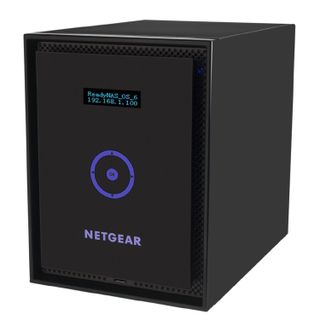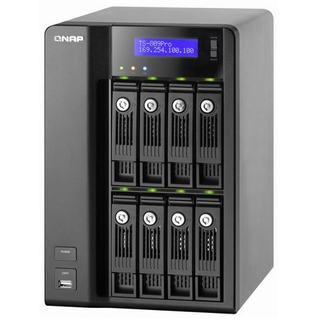Drobo B810n 8-Bay NAS Review
Drobo. Now that's a name we haven't heard in a long time. The company is back, and it sent us its new Marvell-powered B810n storage appliance to test. Is there new magic in this once-prolific brand, or does it fail to reignite that old flame?
Why you can trust Tom's Hardware
Benchmarks
Notes About Testing
Without support for iSCSI, we can't run a lot of our favorite tests. So, we're implementing a new process for benchmarking network-attached storage. We've actually been planning this for a year but are just getting around to utilizing it. Going forward, you will see performance results with SMB and iSCSI, though this review limits us to SMB.
Comparison Products
We chose two products to test against Drobo's B810n: the Netgear ReadyNAS 716 and the TS-809 Pro, an older appliance from QNAP. We tested the Drobo in two configurations, both using hard drives in RAID 6. Our baseline employs eight Seagate Enterprise NAS 6TB disks, while the second setup utilizes Drobo's auto-tiering function with three SanDisk Extreme Pro 240GB SSDs and five Seagate Enterprise NAS 6TB hard drives. You can use a single SSD for caching, but to fully benefit from auto-tiering, three SSDs are required.
Sequential Read Performance



Every system we've tested with a Marvell processor has displayed some type of abnormality in the test results. That isn't always a bad thing. One low-cost NAS we reviewed actually demonstrated better sequential write performance than anything else in its class. Most of the time, though, the odd behavior goes the other way and we uncover lower performance than competing Intel-based machines.
Indeed, the B810n encounters a dip in our sequential read test with 512KB blocks, and it happens with or without caching. When we enable the cache, Drobo's B810n does perform at the same levels as its competition with few outstanding commands.
Sequential Write Performance



The sequential write tests show more consistency, though we don't see much of a speed-up from auto-tiering. Then again, we usually don't expect a boost from flash in sequential workloads since the feature is tuned to accelerate random transfers of small blocks.
Sequential Mixed Performance




Mixed workloads are often overlooked in network storage testing. But if you run software directly from the NAS, a lot of files get updated and the system juggles data moving in both directions at the same time. Professional photographers have a long history of using Drobo, and many edit their work directly from networked storage. Because of that unique market, we think sequential mixed workloads are more prevalent than the random mixed workloads that take precedence on iSCSI-equipped appliances.
The B810n performs well here, and it fares even better with auto-tiering enabled. I suspect that Drobo plays off of its customer base and tunes the system for this type of workload.
Random Read Performance



Our random read and write tests make it pretty clear that Marvell's quad-core SoC isn't as powerful as competing solutions from Intel. Drobo's B810n performs poorly when we tax it with small blocks of data read and written randomly, particularly when it's only armed with mechanical storage. Of course, performance improves with a flash-based front end, as you'd expect. But the flash is still held back by low processor performance. When we add a solid-state cache to competing platforms, random read performance often increases beyond 2000 IOPS. The cache-enabled B810n only manages to match the other systems with an Intel SoC and disk drives (no flash-based cache).
Random Write Performance



Random write performance is very low when we only arm the B810n with hard drives. Again, flash helps, but not as much as it benefits the Intel-based NAS servers. Some systems, like Netgear's RN716X and many products from Asustor, use DRAM as a random write buffer. That's what we see from Netgear's entry.
One phenomenon we observed from the B810n was that random write performance held steady, even when we increased block size. QNAP demonstrates similar behavior, and that's why we chose it to appear in today's review. With most products, IOPS drop as the block size increases.
Random Mixed Performance




Random and mixed workloads stress the processor. Combining both yields a worst-case scenario for most networked storage devices. With auto-tiering, the B810n manages to outperform the other models in our charts. But without the aid of flash, performance drops to very low levels. We like to see numbers at or above what a single hard drive delivers attached directly to its host via SATA, but that's not the case with Drobo's B810n.
Standard Server Workloads










Our server workloads model popular tasks performed with network-attached storage. We don't see anything new in this set of tests that we didn't already observe on the previous page. Drobo's B810n suffers from poor performance when it's loaded with mechanical disks, but catches up when it's complemented by a flash-based cache. The latency over IOPS charts prove that this system is underpowered in heavy workloads.
Trace-Based SMB Workloads












When we lighten the workload to match desktop-oriented apps, the story changes. In many of these tests, our results are much better than the synthetic benchmarks had us expecting. That's good, since the tests in this section are more inline with what Drobo tuned its platform to handle. Therefore, we weigh these tests more heavily than the others.
Multi-Client Office Workloads


Drobo says its auto-tiering feature is a way to maintain performance when several clients access the NAS simultaneously. We find this to be true, though it's not effective if the workload increases beyond a certain point. Moreover, auto-tiering didn't pick up our Office workload, and that is troubling since the traces are recorded with real Microsoft Office applications running on another storage platform. This is the first system we've tested with an SSD-based cache that failed to detect and accelerate Office back to individual clients.
Stay on the Cutting Edge
Join the experts who read Tom's Hardware for the inside track on enthusiast PC tech news — and have for over 25 years. We'll send breaking news and in-depth reviews of CPUs, GPUs, AI, maker hardware and more straight to your inbox.
-
Khimera2000 Would of like to see the qnap tvs-871 i3 in the review. Its in the same price range. The qnap model mentioned in the article isnt even stocked on newegg any more, and although it makes for nice charts it does nothing from a buyers perspective.Adding something that might of passed end of life just skews performance expectation at the given price point.Reply
Just my opinion on it. -
firefoxx04 $1600 with only 2gb ram and no support for zfs (or equivalent). Pretty sad when they market it for big data. Raidz2 with 3 or 4tb disks would be nice.Reply -
Blytz Have to say I would get another DS1815+ Synology unit over that drobo any day of the week. Equal or better specs, about 1/2 the price.Reply
Not to say the Drobo is a poor unit, just very overpriced for what's on off -
Xajel I wonder when NAS becomes more home friendly in pricing and features... Dual Lan port with Link aggregation and 4-6 bays with support for expandability using USB 3 drives ( or another DAS ) for timely backups is not that much of a problem... wondering why prices for such features are very highReply -
DPichugin Drobo b810n has 2 ethernet ports, and support port bonding. It was not clear whether bonded port configuration was used for benchmarking. I would expect different numbers for bonded port test. see https://en.wikipedia.org/wiki/Link_aggregation for details.Reply


